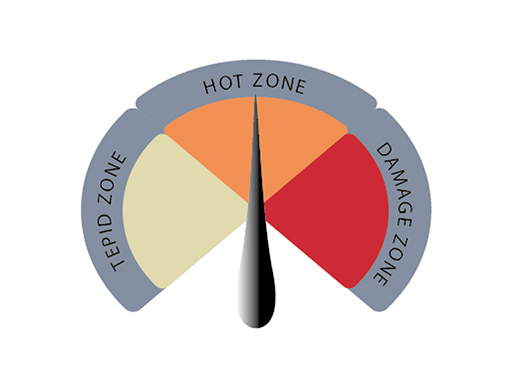1.2 Dialling conflict up and down with CRT
In leadership, you can think of part of your job as dialling up and down the conflict within your organisation, group or community as and when circumstances require it. Envisaging this leadership task visually through a dial can be helpful.
At one end of the dial is the tepid zone – this is where destructive consent can flourish (Grint and Smolović Jones, 2022). Everyone gets along superficially, although under the surface people are probably suppressing all kinds of frustrations. With your knowledge of CRT, you can assume that in this tepid zone, it is likely that significant assumed whiteness exists and acts of expansionism can go unchallenged. The danger with this zone is that people do not feel empowered to speak up, and therefore the organisation risks causing damage through harmful decisions or behaviours. For example, people might feel too disempowered to challenge poor police practice. Or, less seriously, the practices of societies and groups risk becoming outdated.
At the other end of the dial is the damage zone, where you have very bitter and personalised forms of conflict. People may try to harm or even destroy one another, in terms of their standing within an organisation, their career. or worse. Opponents of racial equality – not to mention a CRT interpretation of the world – can be very thin-skinned and quick to claim victimhood, as if dominating other people is somehow their right. So, you should be conscious that some people might be easily tipped into this damage zone. The repercussions may not ultimately matter in terms of you attaining your goals, in the event that such people are ignored as extremists. However, you do need to be aware that some might have powerful allies in the press, well-funded organisations, and other sections of society. Worse still, you need to be aware of the activity of far-right white supremacist groups, who leverage conspiracy theories and play on fear, as well as taking violent action. If you experience intimidation or threats of any kind, make sure to seek advice from the networks available to you: trusted mentors; Equality Diversity and Inclusion (EDI) leads at work; your local council; local Black and Minority Ethnic Networks; local voluntary sector support groups; faith leaders; your elected officials. If necessary, you can scale up to regional and national networks. You should also inform the police – the heat can be turned up on the police, too, to ensure that they are upholding their responsibilities.
Ideally, an organisation committed to generative leadership that enhances racial equity and justice needs to be in the hot zone for as long as can be sustained. This is the sweet spot, where status quo ideas and identities are up for grabs in the heat of good, constructive conflict. It’s where you can push into agonistic mess, to use the terminology of Week 6. The aim of this conflict is always helping people and organisations grow, using ideas from CRT and other perspectives to shift identities and practices.
The leadership scholar Ronald Heifetz (1994) talks about the need for people in leadership to judge when a situation needs to be warmed up – for the dial of conflict to be turned a notch to the right. It’s not so straightforward to describe when this course of action is appropriate. Ultimately, judgments about when to turn up the heat will be intuitive. Something may feel ‘off’ – a policy or behaviour might make you feel uneasy, nervous, cross, or afraid. At other times, you might notice a certain inertia around the organisation – perhaps positive action on issues related to racial justice is being smothered by bureaucracy, and processes are not working as they should. It’s at points such as these that organisations need to start moving the dial on conflict.
Two notes of caution are needed. First, organisations do need time to recover and recuperate from conflict – no one can be in conflict all the time, otherwise they risk burning out with stress. If you feel that it would be counter-productive to turn up the dial at a particular point in time, you will need to bide your time. Second, the achievability of dialling up conflict will depend on the specific context. Organisations that run according to stricter command and/or management logics are less likely to tolerate conflict than organisations more accustomed to leadership. Of course, organisations can be taught to change their approach to leadership – but ultimately, if you think adopting a conflictual path is too risky for your career and/or health, you can explore other avenues for leadership outside the employment relationship.
Activity 3 Dialling up the conflict
Can you identify a situation in your working life or community work that would benefit from turning up the conflict dial? How could you do so? What would be the prerequisites for you to feel comfortable enough to dial up conflict? Would there be any risks associated with doing so, and is there anything you could do to protect yourself from these risks?
Discussion
There is no single correct answer to these questions – ultimately they all involve context-dependent judgment. However, you should not have to face these issues alone. Try asking people you trust whether they feel similarly to you, and whether they would be prepared to support you in pursuing a more conflictual approach. You can also take advice from a trade union if you think entering into conflict could place your employment or opportunities for career progression in jeopardy. Likewise, dialling up a conflict in a community context should be well thought through. Consulting others and speaking to sympathetic people will help.
Now that you have explored CRT and its relevance to leadership, you will move on to another way in which the product of leaders and leadership can be understood: intersectionality.


